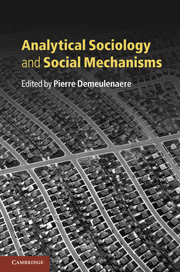Book contents
- Frontmatter
- Contents
- List of figures
- List of tables
- List of contributors
- Introduction
- Part I Action and mechanisms
- 1 Ordinary rationality: the core of analytical sociology
- 2 Indeterminacy of emotional mechanisms
- 3 A naturalistic ontology for mechanistic explanations in the social sciences
- 4 Conversation as mechanism: emergence in creative groups
- Part II Mechanisms and causality
- Part III Approaches to mechanisms
- Index
- References
4 - Conversation as mechanism: emergence in creative groups
Published online by Cambridge University Press: 05 June 2012
- Frontmatter
- Contents
- List of figures
- List of tables
- List of contributors
- Introduction
- Part I Action and mechanisms
- 1 Ordinary rationality: the core of analytical sociology
- 2 Indeterminacy of emotional mechanisms
- 3 A naturalistic ontology for mechanistic explanations in the social sciences
- 4 Conversation as mechanism: emergence in creative groups
- Part II Mechanisms and causality
- Part III Approaches to mechanisms
- Index
- References
Summary
Most explanations are causal explanations: “I ate a snack because I was hungry.” This is a very simple causal explanation: the event of “being hungry” caused the event of “eating a snack.” However, this statement, connecting two states at two successive moments in time, does not provide the full causal story connecting these two events. How, exactly, did “being hungry” cause “eating a snack”? A mechanist would argue that the complete explanation would have to describe the underlying mental state of “being hungry” and how this mental state then caused the neurons in the brain to make the body move into the kitchen and prepare the snack. This would be a very complicated story involving millions of neurons, as well as the relations between the stomach, the brain and the body.
This simple example demonstrates a general property of mechanistic explanations: they commonly describe processes in very complex systems that underlie what, on the surface, appears to be a simple causal relationship. Advocates of mechanistic explanation are most likely to be found in the philosophy of biology and in the philosophy of the social sciences, because both biology and the social sciences are centrally concerned with complex systems. A mechanistic explanation of an event (getting a snack) traces the causal processes leading up to that event by describing the components of a complex system and their interactions (the brain, the stomach sensors that detect hunger).
- Type
- Chapter
- Information
- Analytical Sociology and Social Mechanisms , pp. 78 - 96Publisher: Cambridge University PressPrint publication year: 2011
References
- 5
- Cited by



